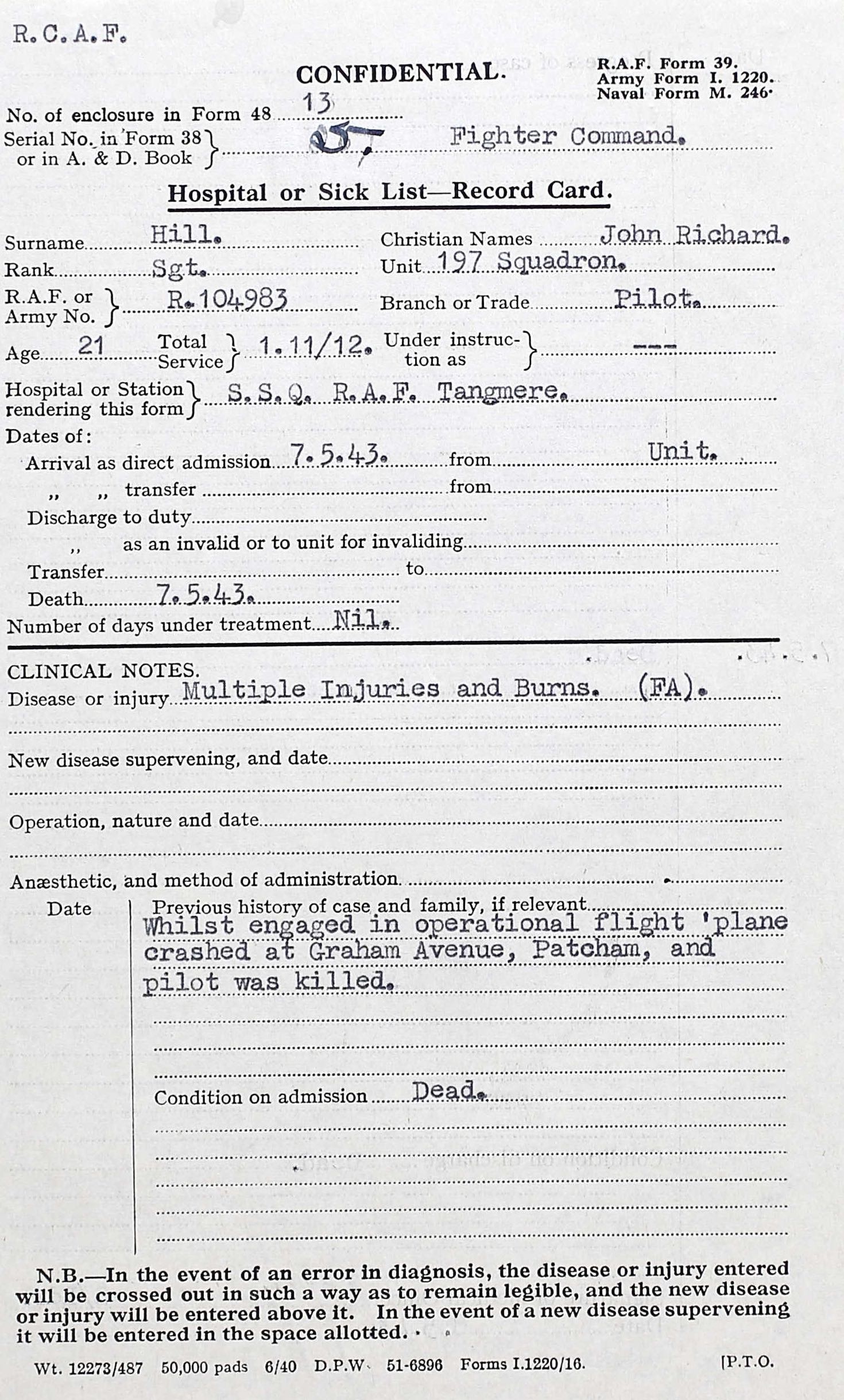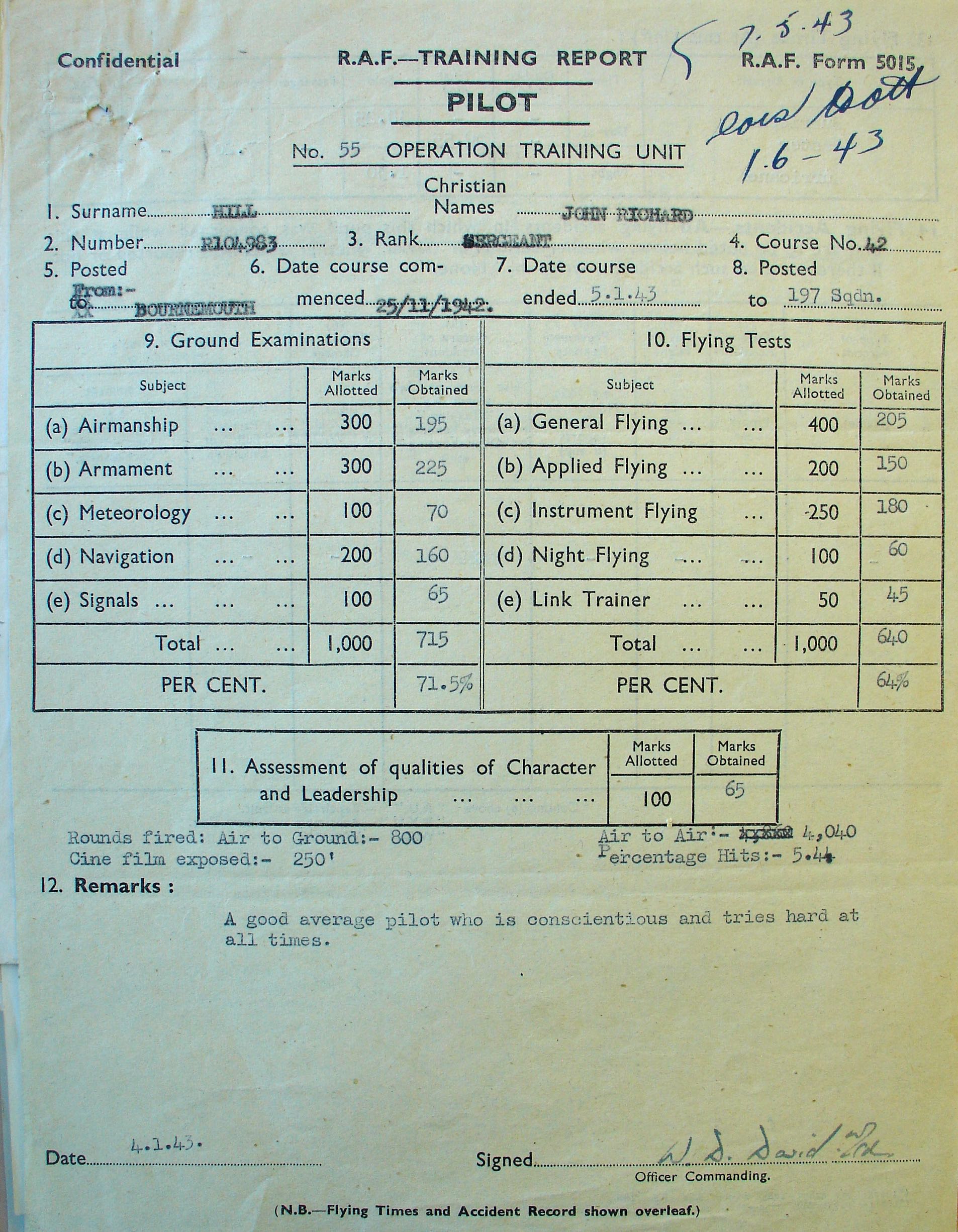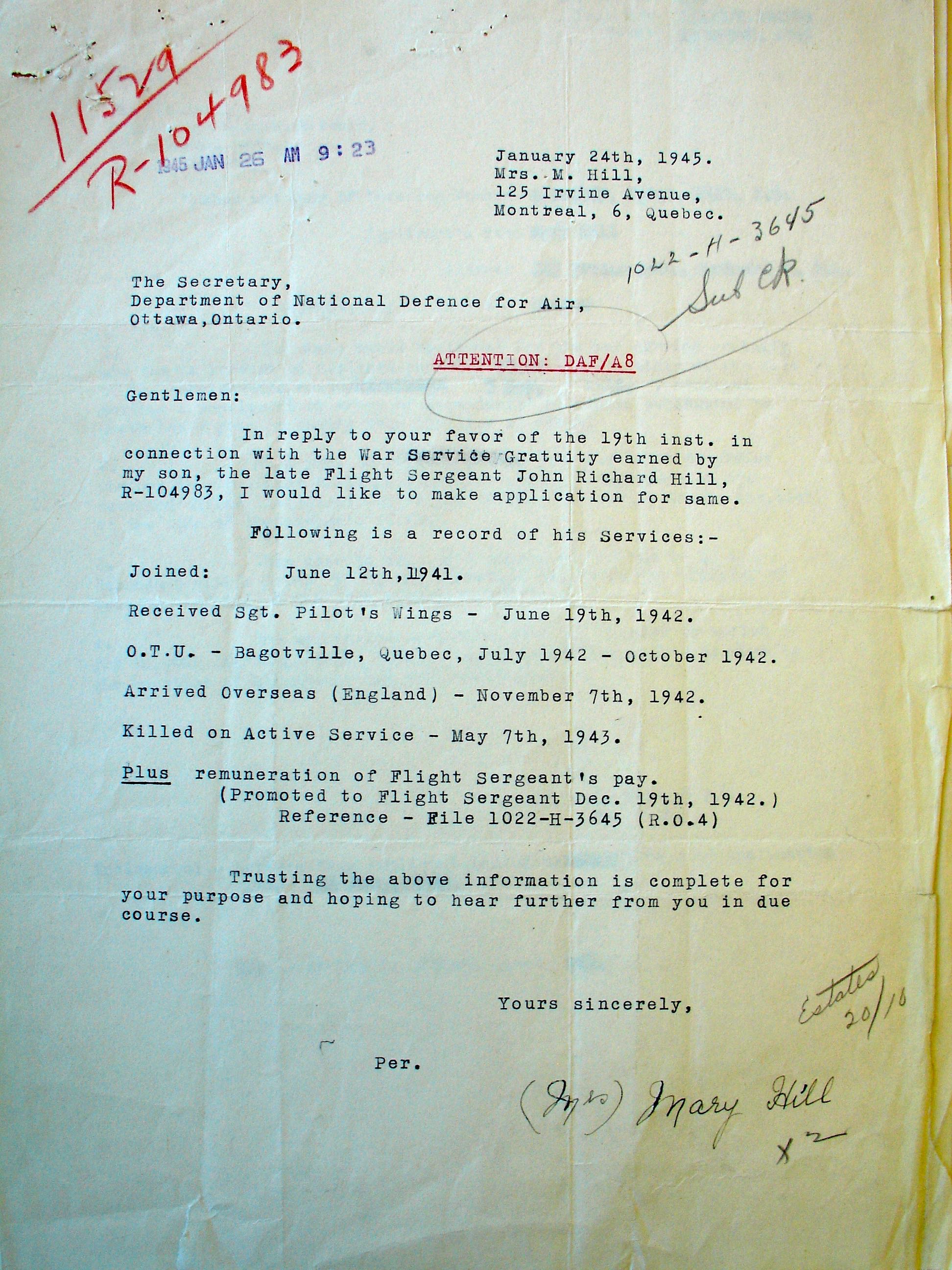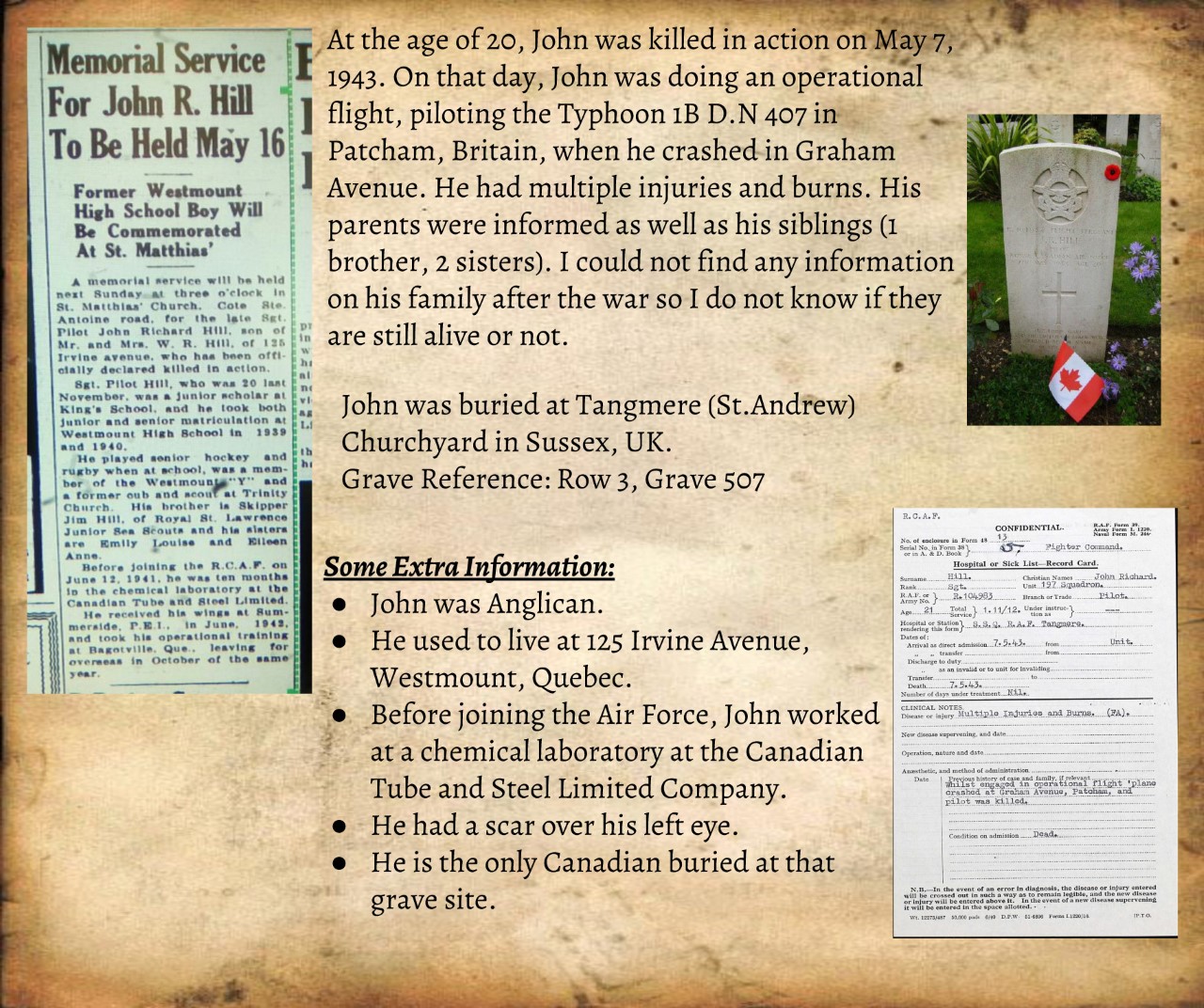







November 12, 1922 - May 7, 1943








John Richard Hill was the son of William Richard and Mary (nee Johnson) Hill of Westmount, Quebec. He had one brother and two sisters. The family was Anglican. He was born on November 12, 1922 in England. He was a steel tester at Canadian Tube & Steel Products Ltd, Montreal, for one year prior to enlistment. He wanted to stay in the RCAF after the war.
He enjoyed hockey, rugby, baseball, basketball and boxing. He smoked a pipe. He did not list any hobbies.
On June 5, 1941, he was assessed. 5' 11", 161 pounds, fair complexion, blue eyes and brown hair. "13 pounds overweight, but excess weight is well distributed and is apparently due to fact that applicant was unable to play hockey whis winter because of pneumonia in October. Otherwise, this man is in excellent condition and is very desirable type personally. Bright young man of good appearance and manners." In September: "Completed Gr, XI and put in one year in Grade XII, but failed in Latin and History, stopping school at 17. Worked for one year testig steel in munitions plant. Left to join up. Choice: Pilot, Observer. Younger than average. Definite, straightforward, alert, quick, responsible lad of good average intelligence. Becomes a little flustered in novel situations, but soon settles down if handled quietly. Has good self-confidence." F/L C. G. Stogdill
He started his journey through the BCATP at No. 4 MD, St. Hubert, on June 6, 1941. He went to No. 1 WS, Montreal, August 1941, then was sent to No. 3 ITS Victoriaville by September 1941 [Talkative. Cheerful and pleasant. Enthusiastic, quick, average intelligence. Fairly calm and self assured. Average. 19/151 in class] He was then in Windsor Mills at No. 4 EFTS [A very slow, plodding type. Rather young and may improve with experience. Unsuitable tof commission at present. Needs practice in aerobatics and steep turns. Link Trainer: 69%. Appears to have quite a bit of promising material in him. Good appearance. Conduct good. Lack of ambition in Ground Training] for three months before going to No. 9 SFTS, Summerside in November.He received his Pilot's Flying Badge on June 19, 1942.
He was at No. 9 SFTS until July 1942 as an instructor.
He was sent to No. 1 OTU, Saguenay July 1942, the to Bagotville in October. He made his way to Halifax later that month, and found himself at the RAF Trainees Pool by November 1942. He was at 55 OTU late November where he was assessed as "A good average pilot who is conscientious and tries hard at all times." He was then posted to 197 Squadron December 28, 1942.
Hill was killed as a result of a flying accident on May 7, 1943 at 1600 hours. He was piloting Typhoon 1B DN407, whilst on a camera gun exercise; location: near Old Farm Road, Patcham, one mile north of Preston Park, Brighton, Sussex, England.
From the ORBs: "More Standing Patrols. One Scramble. Whilst on Cine Gun practice with F/Lt. Elkington, Sgt. Hill J.R. (Canadian) got into a spin. He crashed near Brighton and was killed."
In 1986, Hill's sister, Mrs. Eileen Gilmour, requested her brother's medals. By 1987, she enclosed a cheque for $29.50 to cover the cost.
With huge thanks, in April 2025, a personal recollection by Barry Kensett was shared: "I was five at the time but the event is firmly etched on my memory. I was playing in the back garden, I heard the screaming of the plane and saw the shadow before the aircraft came over our roof and crashed across the wall at the bottom of the garden so the aircraft was partially in our garden and partially on the road where it destroyed a butcher's van. The aircraft fired immediately and I could see the pilot moving in the cockpit but I presume he was already mortally wounded before being burnt. My mother and grandmother were in the house and heard me scream so knew I was OK. I was then whisked away to Grannie's.
"In the family we often referred to “the plane crash” but it is only recently I searched for information. I knew it was a Typhoon. We used to watch Typhoons chasing V1 drones, one of the few aircraft that could catch them in a shallow dive. The objective was to get them down one way or another into the South Downs before they could get to London.
"Rumour said that there was initially concern over the welfare of the butcher but he was in a house up the road, not in his van. Further rumours suggested he was up to something naughty but I have no evidence to support that!
"I attach a current street view of the crash site, the 42 on the gate refers to the back way into our garden. Our house is in the background but the loft extensions were not there in our day. The crash site was across the fence which was a brick wall at the time."
From 197 Squadron's Lance Byrne, researcher: "Sgt Hill wasn't with 197 for very long, joining the Squadron at RAF Drem, Scotland whilst the Squadron was still under training before moving with the Squadron to RAF Tangmere on operations. At that time 197 Squadron was still a fighter squadron tasked with defending the south coast from German hit and run raiders. At the time of his death Sgt Hill was practising air-to-air gunnery with another 'B' Flight pilot - Flt Lt Tim Elkington. The Typhoon was a difficult aircraft to fly, particularly for an inexperienced pilot. To escape a spin the pilot had to, rather counter-intuitively, dive and build up speed to increase the air flow over the control surfaces and so regain control of the aircraft. This assumed that the pilot had the height in which to do so, Sgt Hill may simply have run out of airspace and time before hitting the ground."
LINKS: